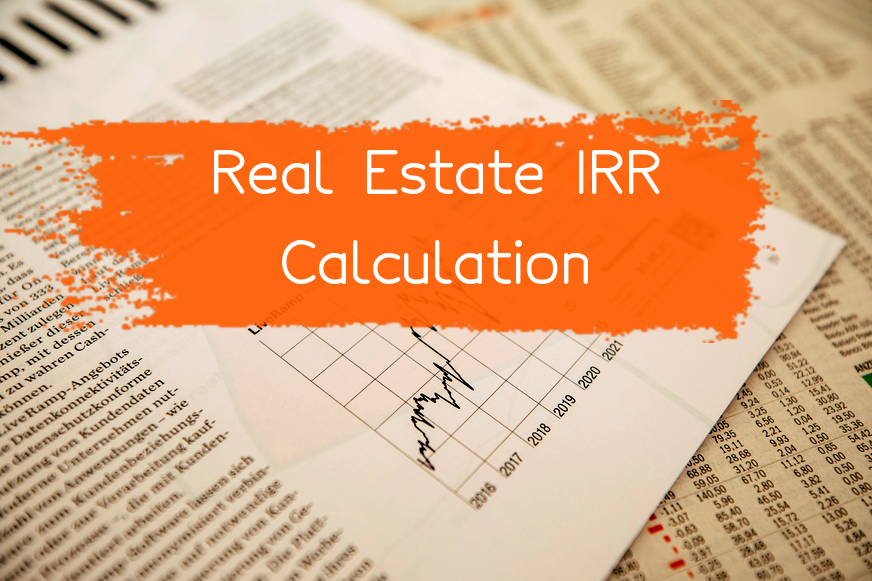The internal rate of return is a metric used to evaluate the profitability of an investment in real estate. It is a percentage that represents the rate at which the investment is expected to generate returns over the investment period.
To calculate the internal rate of return, follow these steps:
- Step 1: Determine the cash flow of the investment
The cash flow of the investment includes all the cash inflows and outflows that are associated with the real estate project. This includes the purchase price, the renovation cost, the rental income, the operating expenses, and the sale proceeds.
- Step 2: Estimate the future cash flows
Estimate the future cash flows of the investment, including the rental income, the operating expenses, and the sale proceeds. These projections should be based on historical data and realistic assumptions about the real estate market.
- Step 3: Calculate the initial investment
Calculate the initial investment required to acquire the real estate project, including the purchase price, closing costs, renovation costs, and other expenses.
- Step 4: Calculate the discount rate
The discount rate is the rate of return used to determine the present value of future cash flows. The discount rate should reflect the risk associated with the real estate investment.
- Step 5: Use a financial model or calculator
Use a financial model or calculator to calculate the internal rate of return based on the cash flow projections, initial investment, and discount rate. The internal rate of return represents the expected rate of return on the investment over the investment period.
In summary, to calculate the internal rate of return in real estate, one needs to determine the cash flow of the investment, estimate future cash flows, calculate the initial investment, calculate the discount rate, and use a financial model or calculator.
IRR Calculator
The IRR (Internal Rate of Return) calculator is a financial tool that is used to calculate an investment's potential return. The calculator allows users to input the projected cash flows for an investment and calculates the internal rate of return that the investment is expected to earn. The IRR is the rate at which the net present value of the investment becomes zero, meaning that at this rate the investment will break even.
The IRR calculator considers the timing and amount of each cash flow to determine the rate at which the investment will yield zero net present value. This rate can then be compared to the investor's required rate of return to determine whether the investment is expected to be profitable or not.
The IRR calculator is a valuable tool for investors, as it helps to assess the profitability of a potential investment by considering the timing and amount of expected cash flows. By calculating the IRR, investors can compare different investment opportunities to determine which offers the highest potential return.
What Is Internal Rate of Return?
The internal rate of return (IRR) is a financial metric used to evaluate the profitability of a potential investment. It represents the discount rate at which the net present value of a series of cash flows equals zero. In other words, it is the rate of return earned on each dollar invested in a project over the life of the project, taking into account the timing and amount of each cash flow. The higher the IRR, the more profitable the investment is considered to be, as it represents a higher rate of return on the capital invested. It is also used as a tool to compare different investment opportunities, as it allows for a standardized method of comparing the potential returns of different projects.
How to Use IRR in Real Estate Investing
Internal rate of return (IRR) is a method used in real estate investing to calculate the profitability of a real estate investment. The IRR essentially helps investors determine how much money they can expect to make from a property over time.
The following are some steps to use IRR in real estate investing:
- 1Determine the cash flow: To calculate the IRR, you need to determine the cash flow of the property. This includes rental income, any supporting factors, such as parking or laundry, and all expenses such as taxes, insurance, maintenance, and repairs expenses.
- 2Estimate the future cash flow: Based on the cash flow determined, you need to estimate future incomes and expenses that are likely to occur. It may include rent increases, new tenants, renovations, and repair expenses.
- 3Determine the purchase price: The price of the property is an essential element of calculating IRR. The purchase price should reflect the current market value of the property, and the future income and expenses should be based on that.
- 4Calculate IRR: Using the estimated cash flows and purchase price, calculate the IRR. This percentage represents the overall rate of return that an investor can expect to earn from the investment.
- 5Compare IRR with other investment opportunities: Compare the calculated IRR of the property with other investment opportunities to determine the best investment option.
- 6Select the right investment property: If the calculated IRR meets or exceeds your investment goals, it may be a sound investment strategy. Use IRR in conjunction with other financial criteria to make your real estate investment decisions.
In conclusion, IRR analysis is an efficient method for measuring return on investment (ROI) in real estate investments. It considers various factors such as cash flows, time value of money, and other financial metrics. A high IRR represents a better investment than lower IRR as it means a higher return on the investment made.
Just one more thing: if you liked the article, please like us on social media and share this article with friends.



